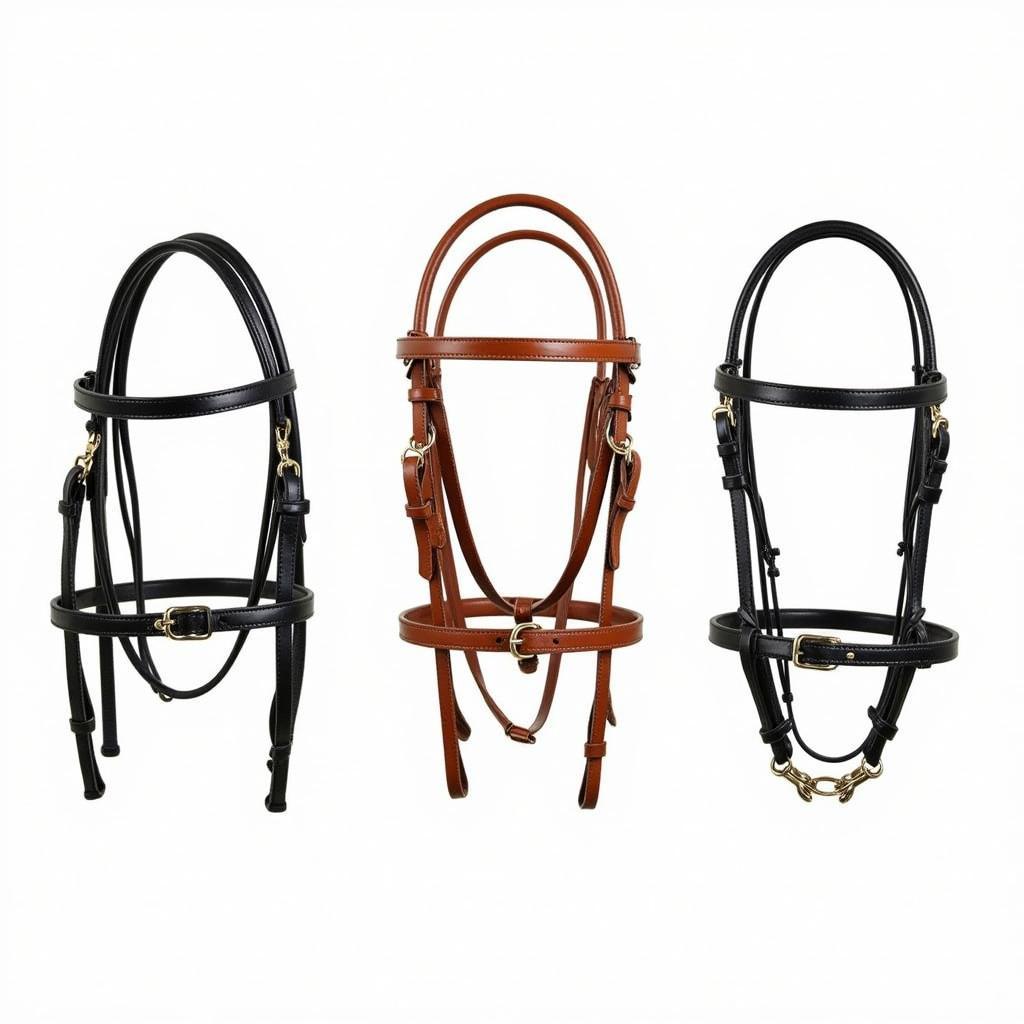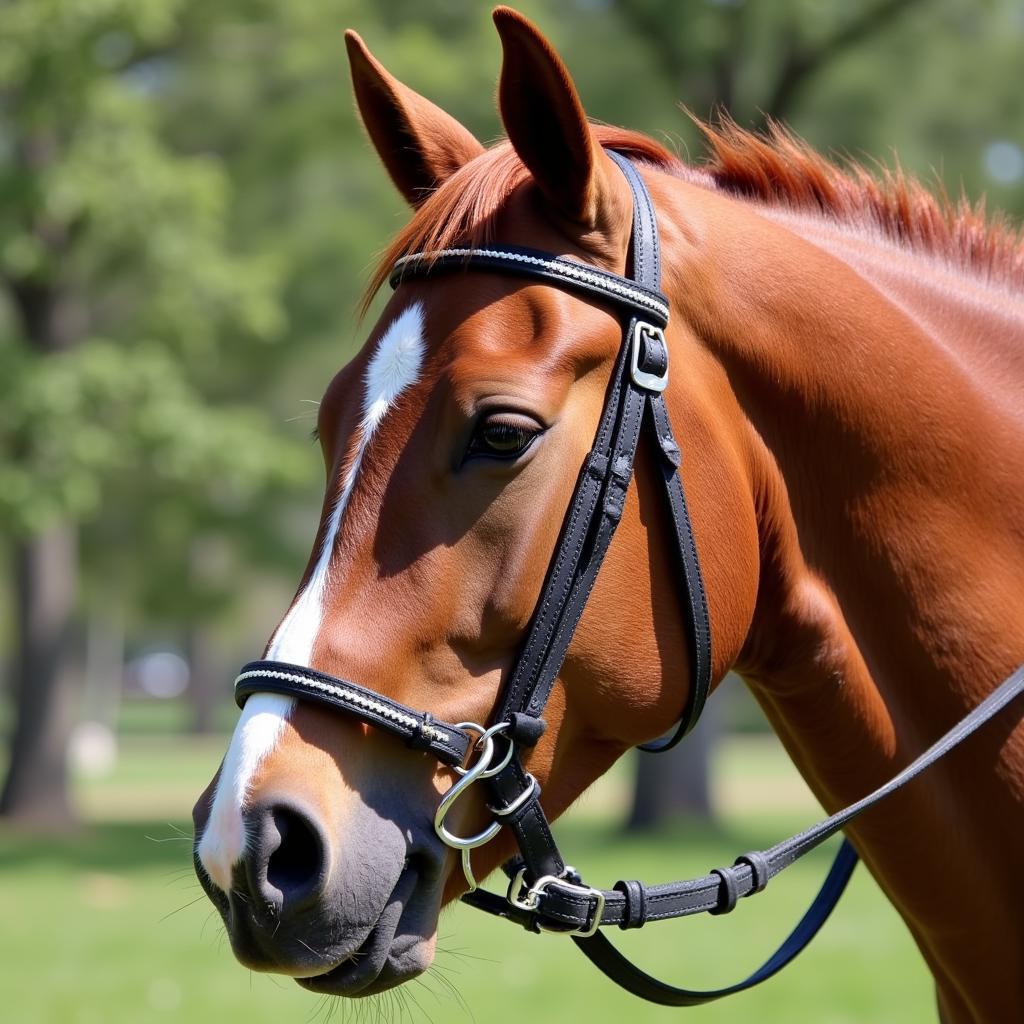A Walking Horse Bridle is an essential piece of equipment for any rider who enjoys this smooth and distinctive gait. But with so many options available, it can be overwhelming to find the right bridle for your horse. This guide will explore the different types of walking horse bridles, key features to consider, and offer expert tips to help you make an informed decision.
 Different Walking Horse Bridle Types
Different Walking Horse Bridle Types
Understanding the Walking Horse Bridle
Before delving into the specifics, it’s crucial to understand what sets a walking horse bridle apart. Walking horse bridles are specifically designed to enhance the natural gait of gaited horses, particularly emphasizing the smooth, four-beat “running walk”.
Types of Walking Horse Bridles
There are several types of walking horse bridles, each catering to different riding styles and preferences. Some of the most common types include:
- Flat Walk Bridle: Known for its simplicity, the flat walk bridle is a popular choice for training and everyday riding. It typically features a plain cavesson and browband, minimizing distractions for the horse.
- Performance Walking Horse Bridle: Designed for the show ring, performance bridles often feature elaborate detailing, decorative stitching, and silver accents. They aim to complement the horse’s conformation and enhance its overall presence.
- Trail Riding Walking Horse Bridle: Durability and functionality are paramount for trail riding. These bridles are typically crafted from sturdy leather and may include features like browband knots or slobber straps for added comfort and practicality.
Key Features to Consider
When selecting a walking horse bridle, several factors warrant careful consideration:
- Material: Leather remains the most popular choice due to its durability, flexibility, and classic aesthetic. However, synthetic materials like biothane offer excellent strength, easy maintenance, and vibrant color options.
- Fit: A well-fitting bridle is essential for your horse’s comfort and performance. Ensure the crownpiece, cheekpieces, and throatlatch are properly adjusted to avoid pinching or rubbing.
- Bit Type: The choice of bit can significantly influence a horse’s gait and responsiveness. Snaffle bits are milder, while curb bits offer more leverage. It’s best to consult with an experienced trainer or equine professional to determine the most suitable bit for your horse’s training level and temperament.
- Cavesson Design: The cavesson should sit comfortably on the horse’s nose without restricting breathing or interfering with the bit. Different designs, such as flat cavessons, figure-eight cavessons, and flash cavessons, offer varying levels of control and pressure points.
- Reins: Rein material and style can impact grip and communication with the horse. Consider factors like weather conditions, your riding discipline, and personal preference when choosing reins.
Finding the Perfect Fit
“[Awesome road horse] need properly fitted tack,” says Sarah Williams, a certified equine riding instructor with over 20 years of experience. “A poorly fitting bridle can not only cause discomfort but also hinder your horse’s performance and even lead to behavioral issues.”
To ensure a proper fit, consider these tips:
- Measure your horse: Before purchasing a bridle, measure your horse’s head using a flexible measuring tape. Refer to the manufacturer’s size chart for guidance.
- Check for pressure points: After bridling your horse, check for any signs of rubbing or discomfort. The bridle should lie flat against the horse’s head without gaps or excessive tightness.
- Observe your horse’s behavior: Pay attention to your horse’s demeanor while being ridden. Signs of head tossing, resistance, or agitation could indicate an ill-fitting bridle.
 Properly Fitted Walking Horse Bridle
Properly Fitted Walking Horse Bridle
Caring for Your Walking Horse Bridle
Proper care is essential to prolong the life of your bridle and ensure its safety. Regularly clean your bridle with saddle soap and leather conditioner to prevent drying and cracking. Inspect the stitching, buckles, and other hardware for signs of wear and tear.
Conclusion
Choosing the right walking horse bridle is crucial for both horse and rider. By understanding the different types, key features, and fitting considerations, you can make an informed decision that enhances your horse’s comfort, performance, and overall well-being. Remember to consult with experienced professionals for personalized advice and prioritize regular bridle care for optimal safety and longevity.
FAQs
Q: Can I use a regular horse bridle on a walking horse?
A: While technically possible, it’s not recommended. Walking horse bridles are specifically designed to accommodate the unique head and neck conformation of gaited horses, optimizing their natural gait.
Q: How often should I clean my walking horse bridle?
A: Ideally, clean your bridle after each use to remove sweat, dirt, and debris. A more thorough cleaning with saddle soap and conditioner can be done weekly or bi-weekly, depending on usage.
Q: What are some signs of a poorly fitting bridle?
A: Look for signs of rubbing or hair loss, head tossing, resistance to the bit, and general signs of discomfort or agitation in your horse.
Q: Can I adjust the fit of my walking horse bridle myself?
A: Minor adjustments to the cheekpieces and throatlatch can often be made at home. However, if you’re unsure about proper fit or need to make significant adjustments, it’s best to consult with a professional saddle fitter.
Need More Help?
For more information on horse care and equestrian equipment, explore these articles on our website:
Have additional questions or need assistance with choosing the perfect walking horse bridle? Contact Justus Horses USA at 0772127271 or email us at [email protected]. Our expert team is available 24/7 to help you find the ideal equipment for your equine partner. You can also visit us at QGM2+WX2, Vị Trung, Vị Thuỷ, Hậu Giang, Việt Nam.